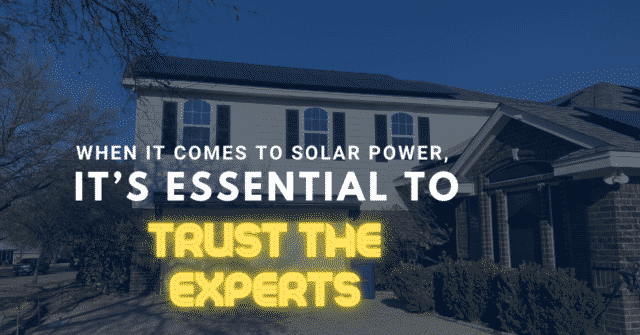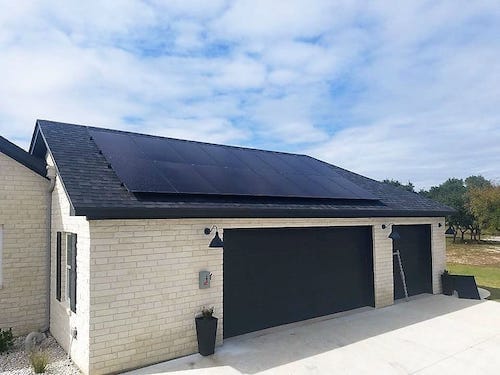Solar is more popular than ever because electricity rates from the utilities are inflating pretty quickly.
With this new demand for solar, comes a bunch of fly-by-night “companies” that want to make a quick buck. Many of you have seen it with the roofing companies who were like vultures after the big hail storm. Well, these new “solar installers” are going to cost you a lot more money and give you even more grief.
Pick a company that knows solar. We’re proud to say “solar is all we do.” We’re not “Roofing and Solar” or “General contractor and solar installer”. We’re solar – 100%.
Many of you know I chair the Texas Solar Energy Society board of directors for 2014. We often talk about the professionalism of the Texas installers because it’s the face of the industry to the general public. We cringe every time we hear a promise of “install these 2 modules on your roof and you’ll save 75%” or hear somebody talking about 3-year paybacks or is charging 80-year old couples $6 per watt installed. It is dishonest…more than that, it’s a lie that will cost you money.
One of my goals this year was to pass a Texas Solar installer code of ethics. I saw it as an affirmation that if an installer signed up for this, he was committed to the industry professionalism. I haven’t passed it yet with the board and our business members, but I do live by it.
So when you work with Solar CenTex, you get a commitment from a team of professionals. A Texas Electrical Contractor, an authorized Oncor solar service provider (with higher than Texas required liability and workers’ compensation insurance), North American Board of Certified Energy Practitioner (NABCEP) PV Installation Professional certification (not just an entry-level passing score). Dozens of local installations – the pictures on our website aren’t stock photos, those are our jobs for our customers. When you go to our contact us page, you’ll see real people. These are the same real people that will install your system – not subcontractors.
If you get a quote from another installer, please pull this out and ask him if he lives by this:
Levelized Cost of Electricityis based on performance warranty period of the modules (25 or 30 years max)
Periods beyond the performance warranty can mislead the buyer as to the true cost of the solar energy created
Kwh production based on industry-accepted software
Proposal generation and modeling software based on data-driven modeling such as PV Watts, System Advisor Model (SAM), or PVSYST delivers a reliable, industry-accepted production forecast so consumers can make informed financial decisions.
Inflation rates for Texas electricity are based on data-driven information
Proposals should use readily available information from the Energy Information Agency and use either the state-average (4.1% electricity inflation, 2012 to 2013, EIA) or the national energy inflation expectation (3.78 %). Depicting 5, 7, 9% inflation sets false consumer expectation.
The consumer is advised of every incentive he is eligible for and if an installer is not eligible or qualified for the incentive, the installer states what he cannot obtain for the consumer
Consumers need local installers to have the knowledge of what is available to them to make solar as cost effective as possible. While some consumers may choose not to take advantage of programs based on their specific circumstances, they should understand what is available to them.
“Rebates” that are not external to the company (i.e. a company “rebate” ) must be explained in the contract
A company-internal “rebate” is simply money taken from the customer up front and then returned to the customer. Companies should not represent these as official incentive programs.
Warranty differences between “material and workmanship” versus performance warranty for the module are clearly explained to the customer
This difference is one of hardest concepts for customers to understand – installers should ensure they clearly explain the difference and provide either paper copy or digital links to the module warranty information.
Installers have received some level of NABCEP or IREC training with company educational plans that lead to their installers’ certifications.
Solar isn’t rocket science but it is still science! Homeowners should expect that the team leader at his home has received the proper industry recognized training. Professional installers may not have everybody certified but they have road-maps to attain certifications for their team.
Written commitment to one year “checkup” to verify annual production and assess variance
If installers give an expected range of solar production, they should check if there is a difference and explain to the customer why there is this difference. This should not be misconstrued as requiring a performance warranty (although some installers may choose to do so).
Roof penetrations are flashed
Even though professional installers think this is the only way, there are still installers putting L-Feet only with sealant.
Electrical work for solar is in accordance with local requirements and the National Electric Code and International Fire Code as adopted by the community
Load side connections to the main supply panel don’t exceed the 120% rule; solar circuits are labeled; arrays are positioned with correct offsets…Professional Texas Solar Installers learn the requirements and implement them, even if not convenient.
A customer “take-home” book is provided to the customer after the installation
Every customer should be provided with either a paper or digital copy that describes his system, and has the documents he will need for future Federal tax and property tax requirements. This should also include a copy of the customer’s excess surplus energy agreement with his retail electric provider, if applicable, as well as his utility interconnection agreement.
Solar CenTex will live by this – we look forward to answering your questions.




